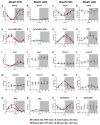Alcohol and Liver Clock Disruption Increase Small Droplet Macrosteatosis, Alter Lipid Metabolism and Clock Gene mRNA Rhythms, and Remodel the Triglyceride Lipidome in Mouse Liver
- PMID: 33013449
- PMCID: PMC7504911
- DOI: 10.3389/fphys.2020.01048
Alcohol and Liver Clock Disruption Increase Small Droplet Macrosteatosis, Alter Lipid Metabolism and Clock Gene mRNA Rhythms, and Remodel the Triglyceride Lipidome in Mouse Liver
Abstract
Heavy alcohol drinking dysregulates lipid metabolism, promoting hepatic steatosis - the first stage of alcohol-related liver disease (ALD). The molecular circadian clock plays a major role in synchronizing daily rhythms in behavior and metabolism and clock disruption can cause pathology, including liver disease. Previous studies indicate that alcohol consumption alters liver clock function, but the impact alcohol or clock disruption, or both have on the temporal control of hepatic lipid metabolism and injury remains unclear. Here, we undertook studies to determine whether genetic disruption of the liver clock exacerbates alterations in lipid metabolism and worsens steatosis in alcohol-fed mice. To address this question, male liver-specific Bmal1 knockout (LKO) and flox/flox (Fl/Fl) control mice were fed a control or alcohol-containing diet for 5 weeks. Alcohol significantly dampened diurnal rhythms of mRNA levels in clock genes Bmal1 and Dbp, phase advanced Nr1d1/REV-ERBα, and induced arrhythmicity in Clock, Noct, and Nfil3/E4BP4, with further disruption in livers of LKO mice. Alcohol-fed LKO mice exhibited higher plasma triglyceride (TG) and different time-of-day patterns of hepatic TG and macrosteatosis, with elevated levels of small droplet macrosteatosis compared to alcohol-fed Fl/Fl mice. Diurnal rhythms in mRNA levels of lipid metabolism transcription factors (Srebf1, Nr1h2, and Ppara) were significantly altered by alcohol and clock disruption. Alcohol and/or clock disruption significantly altered diurnal rhythms in mRNA levels of fatty acid (FA) synthesis and oxidation (Acaca/b, Mlycd, Cpt1a, Fasn, Elovl5/6, and Fads1/2), TG turnover (Gpat1, Agpat1/2, Lpin1/2, Dgat2, and Pnpla2/3), and lipid droplet (Plin2/5, Lipe, Mgll, and Abdh5) genes, along with protein abundances of p-ACC, MCD, and FASN. Lipidomics analyses showed that alcohol, clock disruption, or both significantly altered FA saturation and remodeled the FA composition of the hepatic TG pool, with higher percentages of several long and very long chain FA in livers of alcohol-fed LKO mice. In conclusion, these results show that the liver clock is important for maintaining temporal control of hepatic lipid metabolism and that disrupting the liver clock exacerbates alcohol-related hepatic steatosis.
Keywords: BMAL1; alcohol; circadian clock; fatty acid; lipidomics; liver; steatosis; triglyceride.
Copyright © 2020 Valcin, Udoh, Swain, Andringa, Patel, Al Diffalha, Baker, Gamble and Bailey.
Figures










Similar articles
-
Genetic deletion of the circadian clock transcription factor BMAL1 and chronic alcohol consumption differentially alter hepatic glycogen in mice.Am J Physiol Gastrointest Liver Physiol. 2018 Mar 1;314(3):G431-G447. doi: 10.1152/ajpgi.00281.2017. Epub 2017 Nov 30. Am J Physiol Gastrointest Liver Physiol. 2018. PMID: 29191941 Free PMC article.
-
Chronic ethanol consumption disrupts the core molecular clock and diurnal rhythms of metabolic genes in the liver without affecting the suprachiasmatic nucleus.PLoS One. 2013 Aug 12;8(8):e71684. doi: 10.1371/journal.pone.0071684. eCollection 2013. PLoS One. 2013. PMID: 23951220 Free PMC article.
-
Nobiletin Protects Against Alcoholic Liver Disease in Mice via the BMAL1-AKT-Lipogenesis Pathway.Mol Nutr Food Res. 2024 Jun;68(12):e2300833. doi: 10.1002/mnfr.202300833. Epub 2024 Jun 8. Mol Nutr Food Res. 2024. PMID: 38850176
-
Circadian rhythms, alcohol and gut interactions.Alcohol. 2015 Jun;49(4):389-98. doi: 10.1016/j.alcohol.2014.07.021. Epub 2014 Nov 14. Alcohol. 2015. PMID: 25499101 Free PMC article. Review.
-
Circadian regulation of lipid metabolism.Proc Nutr Soc. 2016 Nov;75(4):440-450. doi: 10.1017/S0029665116000288. Epub 2016 May 26. Proc Nutr Soc. 2016. PMID: 27225642 Review.
Cited by
-
Circadian rhythms and inflammatory diseases of the liver and gut.Liver Res. 2023 Aug 16;7(3):196-206. doi: 10.1016/j.livres.2023.08.004. eCollection 2023 Sep. Liver Res. 2023. PMID: 39958387 Free PMC article. Review.
-
Transcriptional Feedback Loops in the Caprine Circadian Clock System.Front Vet Sci. 2022 Apr 11;9:814562. doi: 10.3389/fvets.2022.814562. eCollection 2022. Front Vet Sci. 2022. PMID: 35478603 Free PMC article.
-
BMAL1/PGC1α4-FNDC5/irisin axis impacts distinct outcomes of time-of-day resistance exercise.J Sport Health Sci. 2024 Aug 24;14:100968. doi: 10.1016/j.jshs.2024.100968. Online ahead of print. J Sport Health Sci. 2024. PMID: 39187065 Free PMC article.
-
Acetylation of proximal cysteine-lysine pairs by alcohol metabolism.Redox Biol. 2025 Feb;79:103462. doi: 10.1016/j.redox.2024.103462. Epub 2024 Dec 12. Redox Biol. 2025. PMID: 39729908 Free PMC article.
-
Time-restricted feeding reduces cardiovascular disease risk in obese mice.JCI Insight. 2025 Jan 7;10(4):e160257. doi: 10.1172/jci.insight.160257. JCI Insight. 2025. PMID: 39812779 Free PMC article.
References
Grants and funding
LinkOut - more resources
Full Text Sources
Molecular Biology Databases
Research Materials
Miscellaneous

